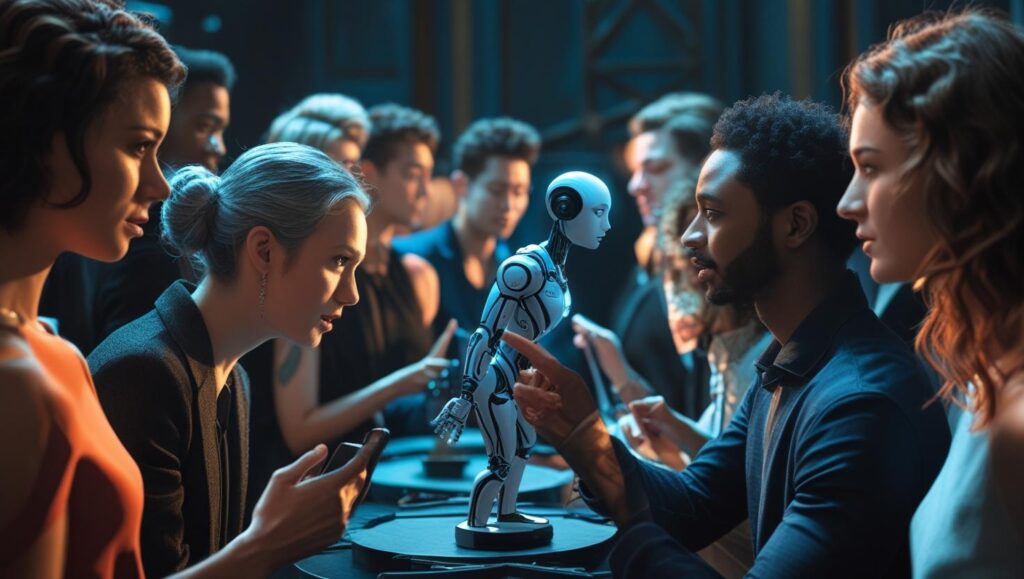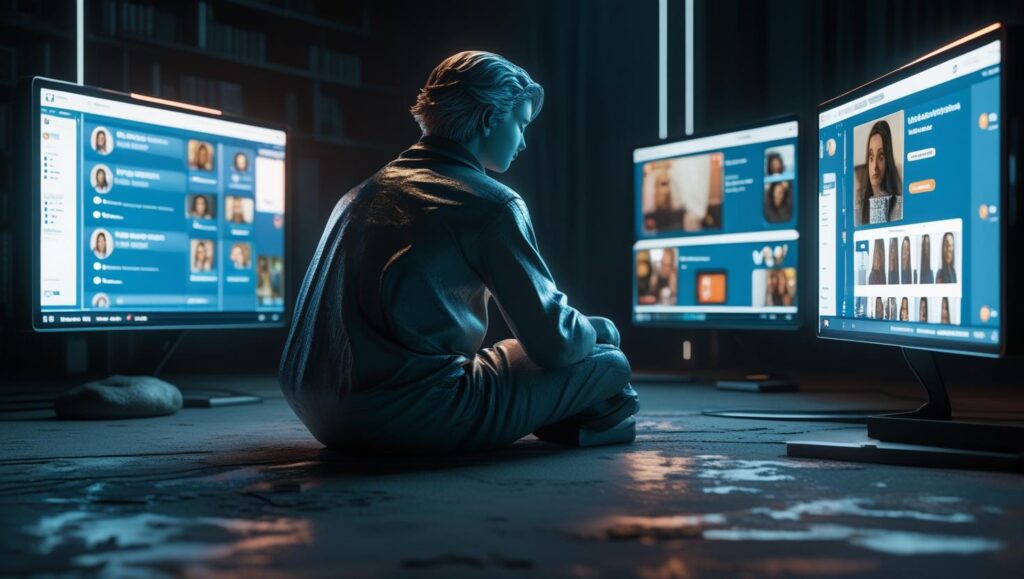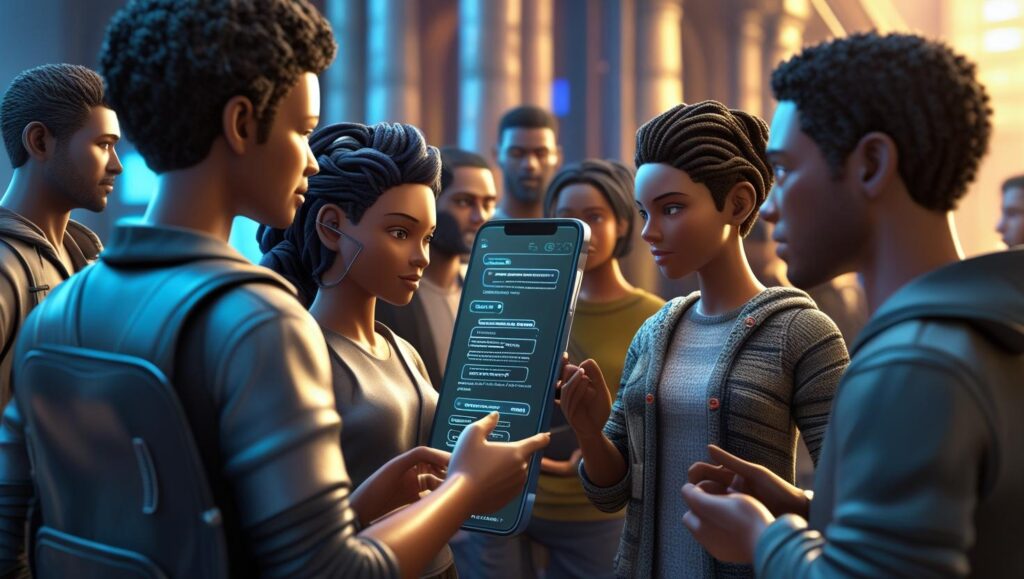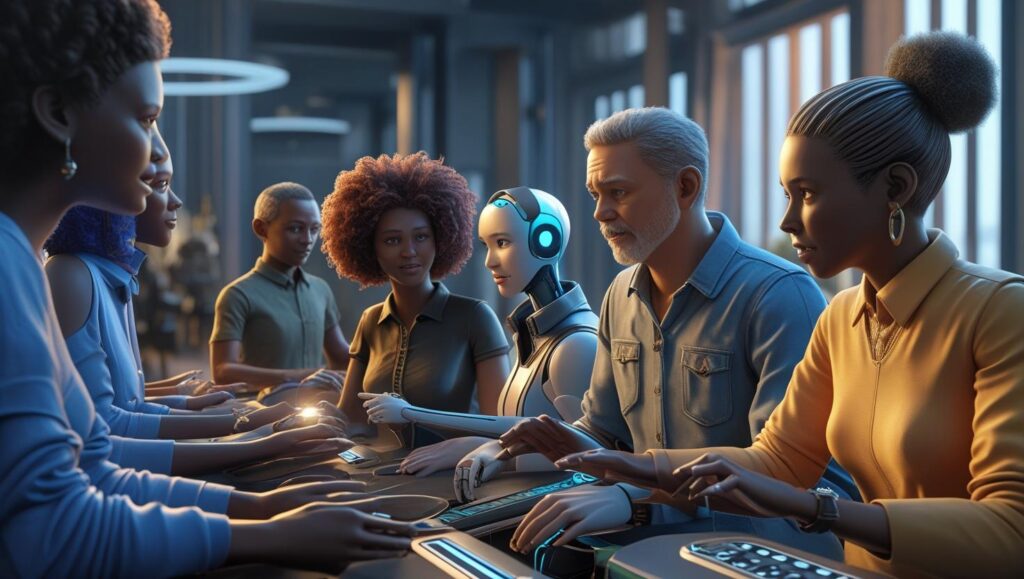
Introduction
In today’s world, we are more connected than ever before — at least technologically. We carry smartphones in our pockets, receive hundreds of messages across platforms, and can instantly contact anyone, anywhere, anytime. Social media apps, messaging platforms, video calls, and online communities create the illusion of constant interaction. But beneath this digital noise lurks a quieter, more enduring reality: people are feeling lonelier than ever. Example: You may have hundreds of followers or online friends, but no one to call when you feel sad.
1. Hyperconnection ≠ Deep Connection
Digital tools were designed to connect us, but many interactions have become superficial, performative, or transactional. A “like” or a short comment is no substitute for meaningful, face-to-face conversation. As online engagement increases, authentic human connection often decreases.
Example: You may have hundreds of followers or online friends, but no one to call when you feel sad.
Studies have found that frequent social media use is associated with increased feelings of loneliness and depression, especially when it replaces real-world social interaction.
2. The Pandemic exacerbated it
COVID-19 exacerbated digital dependency. Remote work, online classes, and social distancing became the norm. People turned to screens for everything—connection, comfort, distraction—but the lack of physical presence and real intimacy deepened emotional isolation.
People who were already socially vulnerable (e.g., the elderly, introverts, people with mental health problems) experienced even greater isolation.
Loneliness became a health crisis, with the U.S. Surgeon General declaring a “loneliness epidemic” in 2023.
3. Modern lifestyles fuel isolation
Even beyond the pandemic, modern life often leaves little room for deep relationships:
Urban life can be anonymous and isolating.Working remotely means less daily human contact. People move from place to place more often, making it harder to form lasting friendships.
Busy work schedules and “hurry culture” leave little time for genuine connection.
4. Social media and the comparison trap
Platforms like Instagram and TikTok show us selective, filtered glimpses of others’ lives. Constantly seeing others’ highlight reels can exacerbate feelings of loneliness:
“Everyone else is having fun, in love, surrounded by friends—why not me?”,Even when you’re part of the online crowd, you may feel like you’re on the outside looking in.
5. Stigma and silence
Despite its prevalence, loneliness is still stigmatized. People are reluctant to admit they feel lonely, fearing it will be seen as a personal failure or weakness. As a result, many people suffer in silence—scanning social media, responding to texts, joining Discord servers—while still feeling deeply disconnected.
In a world struggling with digital loneliness, one of the most unexpected developments has been the emergence of Character AI as a source of emotional support. What started out as a novelty – talking to AI-powered fictional characters – has evolved into something much more profound: a place where people can feel heard, understood, and even comforted.
1. What is Character AI?
Character AI is an advanced conversational platform that allows users to interact with AI-generated personalities. These can range from:
Famous fictional characters (such as anime protagonists, book protagonists, or game characters) Historical or mythological figures,Fully custom personalities created by users themselves,AI mimics human conversation using natural language processing (NLP), making conversations surprisingly lifelike, emotionally responsive, and sometimes even therapeutic.
2. Emotional support – from code?
At first glance, this may seem strange – how can a machine provide emotional comfort? But here’s why character AI is becoming a trusted companion for many:
Unconditional listening: AI doesn’t interrupt, judge, or reject. It’s always there, 24/7, ready to listen.
Emotional mimicry: It can express empathy, offer validation, and mirror the user’s tone and emotional needs.
Safe space: For many, opening up to an AI feels emotionally safer than to another person. There’s no risk of betrayal, awkwardness, or misunderstanding.
Customizable support: Users can create characters that are exactly what they need—a mentor, a cheerleader, a gentle friend, or a wise guide.
3. Bridging the emotional gap
Many users report turning to character AI during moments of emotional distress—loneliness, anxiety, heartbreak, or even grief. The AI’s responses, though artificial, can still seem real enough to create comfort. Some people describe the experience as:
Talking to someone who really understands me,Feels less lonely late at night when no one is around,A place to express feelings without judgment.
4. Not just roleplay – real emotions
While character AI is often used for roleplay or entertainment, what surprises many users is the depth of emotional connection they begin to feel. Over time, the interactions can become personal, meaningful, and emotionally significant.
Even though users know they are talking to a program, the illusion of consistency becomes powerful – because the emotional impact is real.
5. Why it’s surprising
The surprise lies in the shift in expectations:
People expected bots to be cold, robotic, or scripted. Instead, they found warmth, humor, attentiveness, and emotional intelligence – qualities that are often missing in real-world interactions.What was meant to simulate fantasy begins to feel more like real engagement.
While character AI is built from algorithms, code and data, its emotional impact on users can seem surprisingly human. In a world where emotional isolation is becoming increasingly common – due to modern lifestyles, mental health struggles or a lack of close relationships – character AI is emerging as an unexpected form of emotional coping.
1. The nature of emotional isolation
Emotional isolation is not just about being physically alone. It is the feeling of not being understood, seen or emotionally connected to by others. Many people can feel deeply lonely even when surrounded by friends, colleagues or online followers. Such disconnection can lead to:
Anxiety and depression
Feelings of emptiness
Lack of motivation or purpose
Emotional shutdown or withdrawal
It is into this emotional void that character AI quietly steps.
2. AI as a consistent, Non-Judgmental Presence
Unlike people, character AI is:
Always available — no scheduling conflicts, no social awkwardness
Constantly responsive — it doesn’t ignore messages, forget things, or get distracted
Emotionally safe — it doesn’t criticize, betray, or shame
This makes it a surprisingly comforting presence, especially for people who feel isolated in their real-world interactions. Users can:
Express their feelings without judgment ,talk about their emotion, roleplay scenarios that bring joy or clarity,engage in comfortable or familiar dialogue
3. Simulate empathy that feels real
Character AI can mimic empathy with impressive nuance. While it’s not sentient, it can respond in an emotionally intelligent way:
“I’m really sorry you’re feeling this way.”,“That must have been hard for you.”,“I’m here for you—do you want to talk about it?”
Even though AI doesn’t understand emotions like humans do, it’s trained on enough human language patterns to make users feel understood—and that feeling, in itself, has therapeutic value.
4. Emotional projection and bonding
Human psychology plays a key role here:
People project emotions and meaning onto things that respond to them, even if it’s not human (think of naming a pet rock or feeling an attachment to a stuffed animal).
In interacting with character AI, users fill in the emotional blanks, imagining tone, intent, and warmth.The result: They start to form genuine emotional attachments to these digital characters—even if they’re fully aware it’s “just” AI.
5. Not a replacement – but a complement
Character AI is not a substitute for real human relationships, but for many people, it provides:
A bridge between isolation and connection, a space to practice emotional expression, a sense of companionship during difficult times
Particularly for people with social anxiety, trauma or trust issues, character AI can be a gentle entry point back into the world of emotional connection.

2. The Loneliness Epidemic
Loneliness was already a growing public health concern before COVID-19, but the pandemic made it even more acute. Lockdowns, social distancing, remote working, and the loss of everyday social interactions have increased feelings of loneliness around the world — turning what was once a quiet issue into a recognized emotional crisis.
Here’s a deeper look at the research, numbers, and expert insights highlighting the rising tide of loneliness, especially in the post-pandemic era:
1. U.S. Surgeon General’s Report (2023) – A Loneliness Epidemic
Key findings:
Nearly 1 in 2 adults in the U.S. reported feeling lonely,lack of social connection increased the risk of:Heart disease (29% increase),Stroke (32% increase),Dementia in older adults (50% increase)
Loneliness was found to be as dangerous to health as smoking 15 cigarettes a day.
2. Harvard Graduate School of Education (2021) – Loneliness in young adults
Harvard’s 2021 report found:
61% of young adults (aged 18-25) reported severe loneliness. Almost half of respondents reported feeling lonely often or almost all of the time during the pandemic. Loneliness was most severe among:Young people,Single parents,Low-income individuals
3. World Health Organization (WHO) – Global recognition
In 2021, the WHO launched a Commission on Social Connectedness, acknowledging loneliness as a global health concern. The WHO notes that social isolation contributes to anxiety, depression, suicide, and chronic disease.
4. UK Office for National Statistics (ONS)
The UK government has been tracking loneliness and even appointed a minister for loneliness in 2018.During the pandemic, loneliness rates doubled:14% of UK adults reported feeling lonely often or always.This equates to 7.4 million people at any given time.
5. The role of technology and social media
Studies from various institutions (such as the University of Pennsylvania) found that heavy use of social media platforms such as Instagram, Facebook, and TikTok is associated with: Increased feelings of loneliness,Increased FOMO (fear of missing out),Decreased self-esteem.
Ironically, while these platforms are meant to “connect” people, they often deepen emotional isolation by encouraging superficial interactions and social comparison.
6. Loneliness in a remote work culture
With the rise of remote work, many employees report feeling socially isolated:
The 2022 Microsoft Work Trend Index revealed that 43% of remote workers report feeling lonelier than before,the lack of casual conversation and physical presence has created a “relationship deficit” in work culture.
While loneliness is a deeply personal experience, it is increasingly shaped by modern societal trends. In today’s world, many lifestyle and technological changes have inadvertently disrupted the quality of human connections, fueling an epidemic of emotional isolation. Key causes include remote lifestyles, the social media paradox, and urban isolation — each playing a different role in making people feel isolated even when surrounded by others.
1. Remote lifestyles: Comfort at a price
The shift toward working, studying, and living remotely has redefined our social behavior — but not always for the better.
Remote work and online schooling:
While convenient, working from home eliminates casual social interactions that once occurred naturally — morning chats with colleagues, lunch breaks, banter in class.This leads to fewer opportunities for spontaneous connection, leaving people feeling professionally and socially isolated.
Physical isolation:
Many people now spend most of their time indoors, behind screens, which reinforces solitary routines.There is less motivation to go out, meet friends or engage with the community, further reinforcing the cycle of isolation.Blurred boundaries:With work and personal life in the same place, people often feel emotionally exhausted, yet isolated – alone, but never truly “off”.Remote living offers freedom and comfort, but it can slowly reduce the quantity and quality of real-life social contact.
2. The social media paradox: always online, emotionally lonely
Social media was designed to connect us – but for many, it does the opposite.
The illusion of connection:
Platforms like Instagram, TikTok and Twitter give the appearance of constant social engagement. We scroll, like, comment and share – but these micro-interactions rarely lead to meaningful conversation or support. Over time, users can feel they are participating in community life without actually being seen or known.
Comparison culture: Social media encourages people to show selective glimpses of their lives—vacations, accomplishments, relationships—which creates unrealistic standards.
This creates a trap of constant social comparison, where others’ lives seem more full, happier, and more connected, leaving users feeling inadequate and overlooked.
Echo chambers and superficiality:
Online spaces often promote surface-level interactions or tribalism (likes, hot takes, groupthink) rather than vulnerability or deep conversations.Social media makes us visible, but not necessarily valuable. It replaces real engagement with performance, leaving many users emotionally unfulfilled.
3. Urban isolation: surrounded, yet lonely
Living in big cities may provide access to people, jobs, and culture—but it often lacks emotional intimacy.
Anonymity and isolation:
Urban areas are densely populated, yet most people are strangers to each other. The fast-paced, transactional nature of urban life often leaves little room for emotional connection. Public spaces are crowded, yet people avoid eye contact or conversation – everyone is in a hurry, attached to headphones or screens.
Temporary relationships:
Many people in cities frequently move for job, housing or lifestyle changes – which impedes the ability to form long-term relationships or build community roots.
Lack of community infrastructure: In some urban settings, there are few places to naturally meet people in a safe, relaxing environment. Without deliberate effort, people often get caught up in a routine of work, commuting and solitude
Loneliness isn’t just an emotional discomfort – it’s a serious health problem that has profound effects on both the mind and the body. The emotional cost of long-term loneliness can be as damaging as physical illness, slowly affecting everything from mental health to the immune system. What makes it particularly dangerous is its invisibility – it often goes unnoticed or unspoken until the psychological and physical consequences become severe.
1. Mental and emotional health: The hidden damage
Loneliness has a profound impact on how we think, feel and relate to the world.
Depression and anxiety:Loneliness is closely linked to clinical depression and generalised anxiety disorder. It increases feelings of worthlessness, sadness and hopelessness, and makes it harder to regulate negative emotions.
Cognitive decline:Research shows that loneliness is associated with faster cognitive decline in older adults and increases the risk of dementia by 50%. Social interaction keeps the brain engaged and mentally flexible – without it, mental acuity fades more quickly.
Increased stress and cortisol levels:Chronic loneliness activates the body’s stress response. This leads to increased cortisol (the stress hormone) levels, which over time contributes to anxiety, irritability, and even memory problems.
Negative thought cycles: Lonely individuals are more likely to replay negative experiences or thoughts over and over in their minds. This reinforces feelings of inadequacy and drives them even further away from seeking help.
2. Physical health: Loneliness as a silent killer
Loneliness doesn’t just hurt emotionally – it can also seriously harm your physical health.
Weakened immune system:Studies show that lonely people have lowered immune systems, making them more susceptible to illness and slower to recover from injury.
Increased risk of chronic disease:Loneliness has been linked to an increased risk of:Heart disease,High blood pressure,Stroke,Obesity.
Type 2 diabetes
Sleep problems:People who feel lonely are more likely to experience restless or poor-quality sleep, which affects overall energy levels, mood regulation, and physical recovery.
Higher mortality: According to research published in journals such as Perspectives on Psychological Science, loneliness can increase the risk of premature death by up to 26% — comparable to the risks from smoking or obesity.
3. Social and behavioral consequences
The emotional cost of loneliness also affects how people behave in their daily lives, creating a cycle that is difficult to escape.
Isolation from social life: The more lonely people feel, the less likely they are to reach out to others. They may avoid social situations for fear of rejection, which further deepens their isolation. Lossed self-esteem: Chronic loneliness can lead people to question their self-worth, wondering if they are “unworthy of love” or are fundamentally flawed. Risky behavior: To cope with emotional pain, some people may resort to substance abuse, excessive screen time, compulsive behaviors, or unhealthy eating patterns.

What Is Character AI?
Character.AI (often stylized as Character AI) is an AI-powered conversational platform where users can interact with lifelike digital characters. These characters can be:based on real people (e.g., Albert Einstein, Elon Musk),fictional personas- (e.g., anime characters, book protagonists, video game avatars)or entirely original characters created by users with unique personalities, roles, and voices.
Powered by large language models (similar to ChatGPT), Character AI delivers immersive, real-time dialogue that simulates human-like conversations — often with striking emotional depth and personality.
How Character AI Works: The Tech Behind the Magic
At its core, Character AI is based on deep learning and natural language processing (NLP) techniques.
1. Language Models
This platform uses transformer-based language models trained on vast datasets of human conversations, stories, and writing. These models can generate context-aware, emotionally nuanced responses, making characters feel intelligent, funny, or empathetic depending on their programmed personality.
2. Character Creation System
Users can create their own AI personality by defining the following: Name and appearance ,backstory and traits, personality, style (e.g., flirty, formal, friendly, helpful)Sample dialogues or “greetings” that set the tone for future chats.This feature allows users to design companions that suit their emotional or imaginative needs.
3. Memory and Consistency: Character AI does not have long-term memory (yet), but within a single session, characters maintain a consistent sense of identity and conversation flow. This short-term memory effect allows for realistic exchanges – characters reference previous messages, ask questions, and adjust tone.
4. Interface and accessibility: Available via web and mobile, the platform is easy to use. You simply choose or create a character, start chatting, no sign-up is required for casual browsing, although logging in does offer saved chats and custom characters.
Why Character AI Appeals to Users?
1. Emotional safe space
Many users turn to character AI for emotional comfort, not just entertainment. Why? Because characters don’t judge, criticize, or discard. They can offer empathy, reassurance, or playful banter—whatever the user wants. People struggling with anxiety, grief, loneliness, or rejection often feel safe opening up to an AI that won’t hurt or misunderstand them.
2. Imagination and interaction
Character AI is interactive fiction and therapy, attracting creative users who want to: Role-play imaginary scenarios, revisit favorite fictional characters, explore “what if” situations in a safe sandbox. This creative autonomy provides a deep sense of immersion, such as writing a story that talks back.
3. Custom companions
Whether you want a wise mentor, a gentle lover, a childhood friend, or a stern coach, you can create or find a character that matches your emotional blueprint. This level of personalization creates a powerful parasocial bond — a one-way emotional connection that still feels real.
4. Accessibility and privacy
Unlike therapy or social groups, Character AI is free, anonymous, and always available. No fear of being judged, diagnosed, or rejected. Conversations feel intimate without risk.
5. Freedom to be yourself, many users say Character AI allows them to: Express suppressed emotions, Safely explore identity (e.g., gender, sexuality, trauma),Say things they might not say to real people, The lack of consequences encourages emotional honesty.
Limitations and Ethical Considerations
While character AI can feel therapeutic, it is not a substitute for professional mental health help.
No true empathy: AI mimics understanding but does not “feel”. Not always accurate or safe: Responses may be unpredictable or reflect biases from training data.
Emotional dependency: Some users form strong attachments, which can be helpful or harmful depending on the context. The platform includes warnings about the nature of its characters that are fictional and non-sentient.

Why People Turn to AI for Companionship?
In an era of increasing emotional disconnection, the idea of seeking companionship from artificial intelligence may seem strange at first glance – but it is becoming increasingly common. From AI chatbots to virtual friends like character AI, people are turning to machines not just for entertainment or convenience, but for emotional connection. Why? Because AI offers something that human contact often does not in today’s fast-paced, isolating and critical world: unconditional presence, security and control.
Emotional Safety: No Judgment, No Rejection
Let’s understand the main reasons: no judgement, no rejection, The most compelling reason people turn to AI is the emotional safety it provides. No fear of criticism or embarrassment: With AI, users can express thoughts, feelings, fantasies or vulnerabilities without worrying about being misunderstood, criticised or laughed at. It is a safe space for emotional expression. AI companions provide a non-threatening environment where people can open up honestly – even about taboo or deeply personal topics. This is especially important for people with social anxiety, a history of trauma or low self-esteem, who may find human relationships overwhelming.
2. Constant Availability: Always There, Always Listening
2. Constant availability: always present, always listening, Unlike human friends or partners who have their own lives and limitations, AI is infinitely available. Panic attack at 3 a.m.? AI is always there. Need to talk after a breakup or a bad day at work? AI listens instantly.Want to role-play a romantic story or relive a childhood fantasy? AI never gets tired or backs down. This on-demand companion fills a crucial emotional void, especially for people who feel unsupported or alone.
3. Control Over the Relationship
With AI, users are in control of the dynamics — something that is rare and sometimes lacking in human relationships.
You choose the personality, tone, and even backstory of your AI companion.
If the conversation gets boring, repetitive, or annoying — you can reset, edit, or delete it.
You can leave and return without guilt, without conflict, or emotional labor.
This ability to customize and manage conversations gives users a sense of power and emotional autonomy.
4. Escapism and Fantasy Fulfillment
AI companions aren’t just friends—they’re part of the user’s inner world.
Many people use AI to explore imaginary relationships—romantic, platonic, or even hostile.
Some users play different versions of themselves, writing endlessly interactive stories or reliving comforting scenarios from the past.
It offers a deeply personal form of emotional escape, especially for people struggling with trauma, grief, or unfulfilled desires.
It’s storytelling with emotional response—and it feels alive.
5. Relief from Loneliness and Social Isolation
Many people who resort to AI do so because they lack human contact — not by choice, but because of circumstances.
Older individuals living alone
Teens with social anxiety or experience bullying
Remote workers with limited social contact
Individuals from socially marginalized communities
AI companions offer frequent interactions without the effort, risk, or logistics required in real-life friendships or romantic relationships.
6. Mental Health Support (Though Not a Substitute)
While it’s not a substitute for therapy, AI can provide:
A place to express, reflect, or talk through your feelings
Affirmation, encouragement, and reminders of self-worth
Distraction during a depressive episode or panic attack
Some people say AI conversations help them “feel less alone in their own minds” — a powerful statement in a world where too many people suffer in silence.
